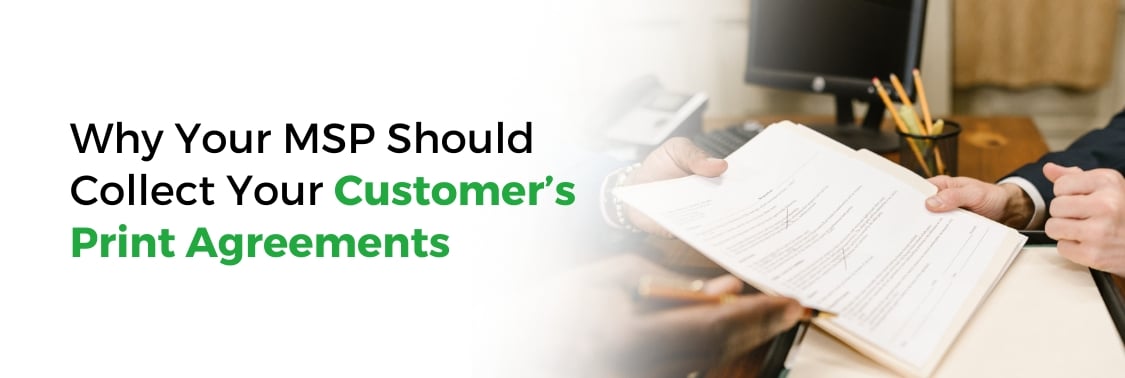MSPs: Always Collect Your Customer’s Print Agreements!

Here’s a common scenario: Your MSP’s support team gets a call from your client. The copier is down, and they have a “very important meeting” tomorrow that they need to print out materials for. It’s imperative that it gets fixed today.
This copier was sold to your customer by some random print vendor. You won’t make a dime on this call, and your team will spend the next half hour grinding out getting the contact info for the print vendor, then calling them to explain the need for urgent support, which they agree to take action on.
Then you get called the next morning by the CEO’s admin, and they bug out HARD because nobody has called them or stopped by yet. You know how the rest of this goes…
Customer perspective: This is all “your fault.” Even though you didn’t sell them the copier, nor are you responsible for its repair, clients tend to pin the blame on any tech-related shortcomings on their MSP.
Like it or not, the relationship between your MSP and your clients’ print vendors is an essential part of your business.
While many MSP owners may want to ignore print entirely, the truth is that your customers rely on their document and printing workflow. And due to the proximity of managed services and print, your support team will often depend on print vendors to get support tickets closed.
Print will always be adjacent to your MSP’s services, so collecting your customer’s print agreements can be a great resource for your team.
This simple yet often overlooked step will equip your MSP with vital information that can significantly enhance operational efficiency and potentially open doors to new business opportunities.
At Print Partner, we recommend always collecting your clients’ print agreements. Make it a standard part of onboarding a new customer. For existing customers, just have your account reps gather them. The information in them can give you key insights into your client’s technology suite, even beyond their printing.
In this article, we’ll review how the information in your clients’ print agreements can bring your business enormous value.
1. Streamlining Support Channels
Collecting a client’s print agreement gives your team insight into the structure of their organization, as well as their print vendor’s chain of command.
This can be a game-changer for your support team. No more guessing games, and no more time wasted by your support staff asking your customer on the fly to provide you with every location’s print vendor info.
The print agreement will include all the contact information you need, which can be seamlessly integrated into your IT documentation repositories like IT Glue.
By doing so BEFORE an issue arises, L1 technicians can easily access this crucial data, eliminating the need to bother customers for support details.
This simple step saves your organization time and money while enhancing the client experience. So do your team and clients a favor, and ask for the print agreement!
2. Identifying Supported Devices and Services
While network connectivity is typically the responsibility of the MSP, print devices can fall under two domains: The MSP (random desktop printers) and the print vendor (Copiers and other desktop printers)
Understanding which devices are covered by which print vendor's support is essential for your MSP to serve your clients properly.
It can sometimes be unclear which parts of the printing workflow are under the responsibility of your MSP, the print vendor, or in some cases, both of you. So, having an agreement that clearly outlines the vendor's expectations can save you from an uncomfortable situation with your customer.
When your client accuses you of dropping the ball, you can refer to the print agreement to see if the issue was something that the print vendor was expected to handle. And if they did, you can bring the issue to their attention.
Armed with this knowledge, you can efficiently allocate resources, as you won't need to handle every support request in a vacuum.
Instead, you can confidently delegate specific tasks to the print vendor, freeing up your own technicians to focus on more complex, revenue-generating tasks.
3. Exploring Additional Services
In the dynamic landscape of managed print services, we recommend that your MSP stays aware of potential competitors operating in your client’s space.
Many managed print vendors offer managed services that compete with your offerings. These types of print vendors are likely trying to poach your clients at their QBRs, saying something like, “You know that we also offer X, Y, and Z with our managed print services… why don’t you let us handle everything?”
To learn more about this phenomenon, read: The Greatest Threat to Your MSP Clients: Managed Print Providers
By examining the print vendor's offerings outlined in the agreement, your MSP can identify if they also provide managed services that compete with yours. It will also reveal if their stack includes elements that you don’t currently offer, but you know your customer is interested in.
This proactive approach empowers your MSP to engage with your clients in discussions about your value proposition and why they should value your services over the print vendors’ managed services.
Nip the issue in the bud before you get that dreaded “It’s not you, it’s me” email from them!
Stay one step ahead of the print vendors, and use their print agreements as intel.
4. Managing Contract Renewals
The last and, in our opinion, the most important reason you should collect client print agreements is to manage and track when contract renewals are set to expire.
By collecting and tracking these agreements, your MSP can proactively engage opportunities to introduce clients to Print Partner.
If you are a current MSP partner in our referral program, you know the benefits of referring clients to us are plentiful - we build a cohesive service structure for your clients and pay you for every opportunity sent our way.
But even if you want to send your entire book of business our way, many clients are locked into contracts with years left before they can switch vendors.
But if you collect agreements, you can easily track and manage account renewal dates. And when one is close to renewal, it gives you an opportunity to send them our way.
In addition to the referral implications, knowing renewal dates can be useful for your MSP to keep up to date on important contacts. Post-renewal, you can ask for the new contracts so that you can stay current on any organizational or changes of personnel with your clients’ print vendor, which will make service and collaboration with the vendor smoother for your team.
Print Partner and Collecting Print Agreements
To properly serve your clients, we recommend collecting the most information about their technology suite as possible.
We’ve found that the print agreement, in particular, serves as an excellent resource, both in the context of Print Partner referrals and in general.
And when you send us referrals, we'll pay you! For each deal we close, we’ll pay the person who registers the opportunity at least $500 for the introduction and an additional $250 per $25K in revenue the deal brings us. For the MSP, we’ll pay $1,000 per 11x17 MFP sold, $100 per printer sold, and 5% recurring revenue on the client’s print allotment. And we’ll provide exceptional client service while we’re at it
Along with commission, we offer you protection from competition and a collaborative service structure for all of our shared clients. Essentially, we make your MSP’s job much easier and more lucrative.
We’ve also added a program to handle your smaller deals, which we’ve called the Xerox Direct Program. To learn more about this program and its unique compensation and service structure, read: No More Minimums! Print Partner's Xerox Direct Program Explained
So if you want to start earning more money for doing less work, start collecting those print agreements and consider partnering with us, a Print Partner you can trust.

.jpg?width=352&name=How%20to%20talk%20to%20your%20MSPs%20customers%20about%20managed%20print%20services_Thumbnail%20(1).jpg)

